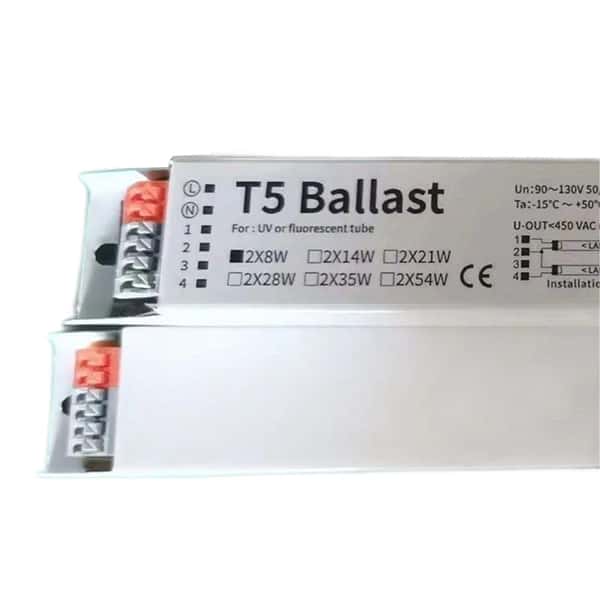When you’re changing out or fixing a lighting system, you want to try to use the stuff you already have to save money. One question that comes up a lot is whether a T8 bulb will work with a T5 ballast. Even though they’re both fluorescent lights, there are some big differences between the two. It’s important to know whether these things will work together so you don’t mess up your lights or have something bad happen.
No, a T8 bulb won’t work with a T5 ballast because there are differences in how much power they use, the voltage they need, and the pins on the end.
We’ll talk about why you can’t use a T8 bulb with a T5 ballast and what you can do if you want to change from one to the other.
What are T8 and T5 bulbs, and how do they differ?
To understand why T8 bulbs can’t work with T5 ballasts, we first need to understand the basic differences between these two types of fluorescent bulbs.
- T8 Bulbs: T8 bulbs are a type of fluorescent lamp with a tube diameter of 1 inch, or 8/8ths of an inch, hence the name T8. These bulbs are commonly used in a variety of applications, from residential lighting to commercial and office spaces. T8 bulbs are energy-efficient compared to older lighting technologies like T12 bulbs, operating at lower wattage—typically 32 watts or less—and using electronic ballasts. They also have better color rendering and more stable light output, making them a go-to choice for cost-effective lighting.
- T5 Bulbs: T5 bulbs are thinner, with a diameter of 5/8ths of an inch, and are designed for more compact lighting fixtures. They are often found in energy-efficient environments, such as modern offices, industrial facilities, and grow lights for agriculture. T5 bulbs operate at higher wattage than T8 bulbs, typically around 28 watts or higher, and they require specific high-frequency electronic ballasts. Their smaller size allows for more streamlined fixtures, but this comes with different electrical demands compared to T8 systems.
While both bulbs are part of the fluorescent lighting family, their differences in size, power, and efficiency mean they are not interchangeable without proper adjustments.
Why can’t a T8 bulb work with a T5 ballast?
Despite their superficial similarities as fluorescent tubes, T8 bulbs and T5 ballasts are fundamentally incompatible. Here are the main reasons why:
- Different Pin Configurations: One of the most immediate issues when attempting to use a T8 bulb with a T5 ballast is the difference in their pin configurations. T8 bulbs typically have a two-pin configuration, which fits into specific T8 fixtures. On the other hand, T5 bulbs have a smaller pin layout. The physical difference in the pins makes it impossible to fit a T8 bulb into a T5 socket without significant modifications. Even if you were able to fit the bulb, the underlying electrical components are not designed to work together.
- Wattage and Voltage Mismatch: T5 bulbs and ballasts operate at higher wattage and different voltage requirements compared to T8 systems. A T5 ballast is designed to handle the higher voltage needed to power a T5 bulb, while T8 bulbs run on a lower voltage. Attempting to use a T8 bulb with a T5 ballast would result in the ballast supplying too much power to the T8 bulb, which could cause overheating, flickering, or even cause the bulb to burn out prematurely.
In fluorescent lighting, the ballast plays a critical role in regulating the current flowing through the tube. T5 ballasts are tailored to the specific needs of T5 lamps, providing the right amount of power to ensure optimal performance. A mismatch in voltage and wattage can also pose electrical hazards, as the T8 bulb is not equipped to handle the higher output from a T5 ballast.
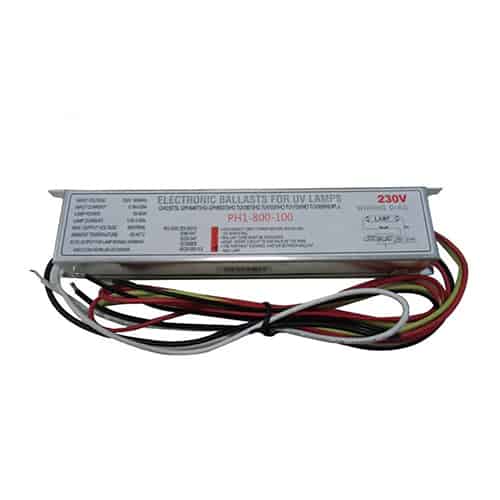
What happens if you attempt to use a T8 bulb with a T5 ballast?
If you mistakenly try to connect a T8 bulb to a T5 ballast, several issues could arise:
- Risk of Damage: The voltage mismatch is the most critical issue. Because T5 ballasts provide higher voltage than a T8 bulb is designed to handle, this could cause the bulb to overheat or burn out quickly. Over time, the excessive power flowing through the bulb will degrade its components, leading to frequent failures or even damage to the ballast itself.
- Incompatibility Issues: Even if you manage to physically install the T8 bulb into a T5 fixture, it is unlikely to operate correctly. The mismatch in electrical requirements means that the T8 bulb will either flicker, produce very dim light, or not light up at all. This incompatibility will lead to an inefficient system and may necessitate frequent replacements.
Additionally, using the wrong bulb and ballast combination could void any manufacturer warranties and increase maintenance costs over time. For commercial spaces, this could mean more frequent downtime, negatively impacting operations.
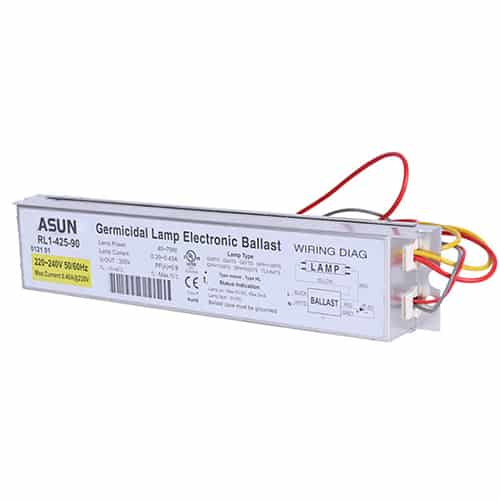
Are there alternatives to using T8 bulbs with T5 ballasts?
While it’s clear that T8 bulbs cannot work with T5 ballasts, there are practical solutions if you need to transition between these systems:
- Ballast Compatibility Solutions: If you need to use T8 bulbs in an environment that has T5 fixtures, the safest and most straightforward option is to replace the T5 ballast with a compatible T8 ballast. This ensures that the system is designed to handle the specific requirements of T8 bulbs, including voltage and current regulation. Ballast replacement kits are available and can be installed by an electrician to ensure safe operation.
- LED Tube Upgrades: Another increasingly popular alternative is to upgrade to LED tubes, which do not require ballasts at all. LED tubes offer several advantages over both T5 and T8 fluorescent lamps. For one, LED tubes are more energy-efficient, providing the same amount of light while consuming less power. They also last much longer than traditional fluorescent bulbs, reducing maintenance costs. Many LED tubes are designed to work without a ballast, and some can be retrofitted into existing T5 or T8 fixtures with minor adjustments.
By upgrading to LED, you not only eliminate the need for a ballast but also gain the benefits of improved energy efficiency, longer lifespan, and better environmental performance.
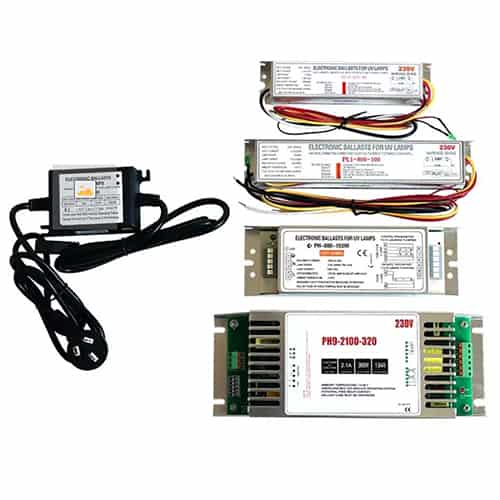
Key considerations when replacing ballasts or bulbs
When it comes to replacing fluorescent ballasts or bulbs, there are a few key factors to keep in mind to ensure safety and efficiency:
- Safety: Always verify that the ballast and bulb are compatible in terms of wattage, voltage, and pin configuration. Using the wrong combination can lead to electrical hazards, including the risk of fire, overheating, or damage to the fixture. It’s always a good idea to consult an electrician when making significant changes to your lighting system.
- Energy Efficiency: Upgrading to LED or using the correct ballast for your T8 or T5 bulbs can significantly improve energy efficiency. Fluorescent lamps with the correct ballast already offer good efficiency, but LED upgrades can further reduce energy consumption and lower operating costs.
- Fixture Compatibility: Make sure the physical fixtures you’re using match the bulbs you intend to install. T5 fixtures are designed for smaller bulbs, while T8 fixtures accommodate the larger T8 diameter. If you plan on switching systems, you may need to replace the entire fixture, depending on the type of bulbs you want to use.
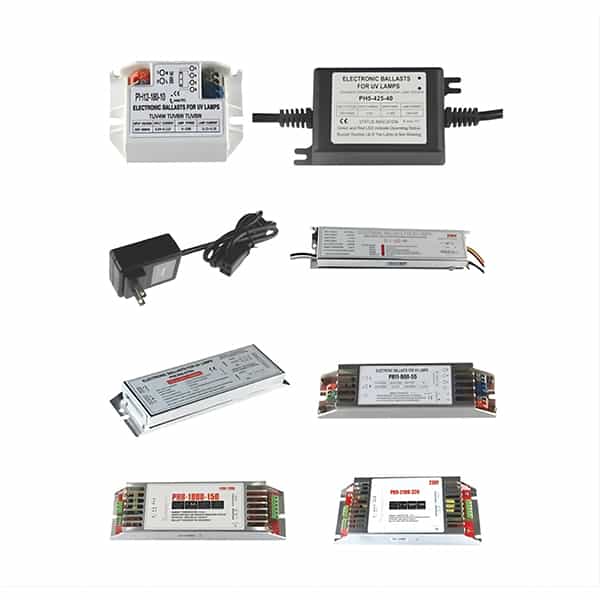
Final Words:
T8 bulb won’t work with a T5 fluorescent ballast because the pins, the voltage, and the watts are different. Trying to make them work together is going to cause you problems, and it might even be dangerous. The best thing to do is to use the right ballast for your bulbs or think about upgrading to LED tubes.

